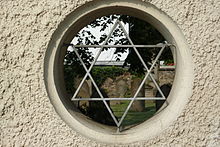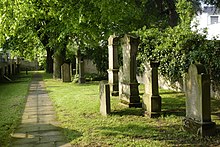Jewish cemetery (Königswinter)
The Jewish Cemetery Königswinter is a Jewish cemetery in Königswinter , a town in the Rhein-Sieg district in southern North Rhine-Westphalia . It is located in the north of the old town on the corner of Rheinallee and Clemens-August-Straße. The cemetery stands as a monument under monument protection .
history
The Jewish cemetery in Königswinter was laid out in the 16th century. It served the Jewish communities of Königswinter , Oberdollendorf and Oberkassel as a burial place. The cemetery was expanded in July 1874 following a resolution by the representative assembly of the synagogue community of the Siegkreis in July 1874 through the purchase of an adjacent arable plot with a size of 234 m²; the costs were raised jointly by the special synagogue communities Oberdollendorf (50 thalers) and Königswinter (45 thalers). When this should also be surrounded by a wall, the Königswinter municipal council spoke out against it in August 1880 and even advocated the relocation of the cemetery to the Oberkassel mayor's office in January 1881 , as the land on the Rhine had become an attractive residential area. Despite a new district medical opinion obtained by the local council, which also spoke out in favor of the relocation, the Upper President of the Rhine Province rejected the objection and thus approved the cemetery expansion including the construction of the wall. When the Siebengebirgsbahn, which ran along the Rheinallee, was built in 1913, the cemetery was reduced in size. In the autumn of 1926, the mayor of Königswinter announced, as a result of the protective measures introduced after a previous Rhine flood, that he wanted to close the burial place with the help of the reference to the hygienic conditions of the burial site.
During the National Socialist era , 15 local citizens applied to the city from June 1933 to close and relocate the cemetery. After the alleged health risks, which were again cited as justification, were confirmed in a district medical report, it was closed on an application by the former provisional mayor and now district administrator of the Siegkreis Buttlar on February 24, 1934 with the approval of the district president on March 9, 1934. At the end of the month, the district administrator rejected an objection by the synagogue community of Königswinter-Oberdollendorf on November 3, 1934, against the closure. In the same year, due to the expansion of today's Clemens-August-Straße from the footpath to the regular street, the cemetery was reduced by 36 m² as part of a job creation measure. What remained was an L-shaped plot of land with an area of 723 m². During the Nazi era, the cemetery was desecrated several times, including during the November pogroms in 1938 .
Today there are still around 80 tombstones ( mazewot ) in the Jewish cemetery, indicated by an information board . The burial place was entered in the monuments list of the city of Königswinter on March 10, 1993.
literature
- Elfi Pracht : Jewish cultural heritage in North Rhine-Westphalia. Part I. Cologne district . Cologne 1997, pp. 530-531 (articles on architectural and art monuments in the Rhineland, vol. 34.1), ISBN 3-7616-1322-9 .
- Angelika Schyma : City of Königswinter. (= Monument topography Federal Republic of Germany , monuments in the Rhineland , Volume 23.5.) Rheinland-Verlag, Cologne 1992, ISBN 3-7927-1200-8 , pp. 40, 111.
Web links
- Entry on the Königswinter Jewish cemetery in the " KuLaDig " database of the Rhineland Regional Association
- Koenigswinter. In: Overview of all projects for the documentation of Jewish grave inscriptions in the area of the Federal Republic of Germany; here: North Rhine-Westphalia; Version: November 2006
- Jewish life in Königswinter - extensive documentation
Individual evidence
- ↑ a b List of monuments of the city of Königswinter , number A 231
- ↑ a b c d Manfred van Rey : Life and death of our Jewish fellow citizens in Königswinter: A book of remembrance (= City of Königswinter, Der Stadtdirektor: Königswinter in Geschichte und Gegenwart , Issue 1, 1985).
- ↑ a b c d e Ansgar Sebastian Klein : Rise and rule of National Socialism in the Siebengebirge . 1st edition, Klartext Verlag, Essen 2008, ISBN 978-3-89861-915-8 . (also dissertation University of Bonn, 2007)
Coordinates: 50 ° 40 ′ 37.5 ″ N , 7 ° 11 ′ 21.6 ″ E



